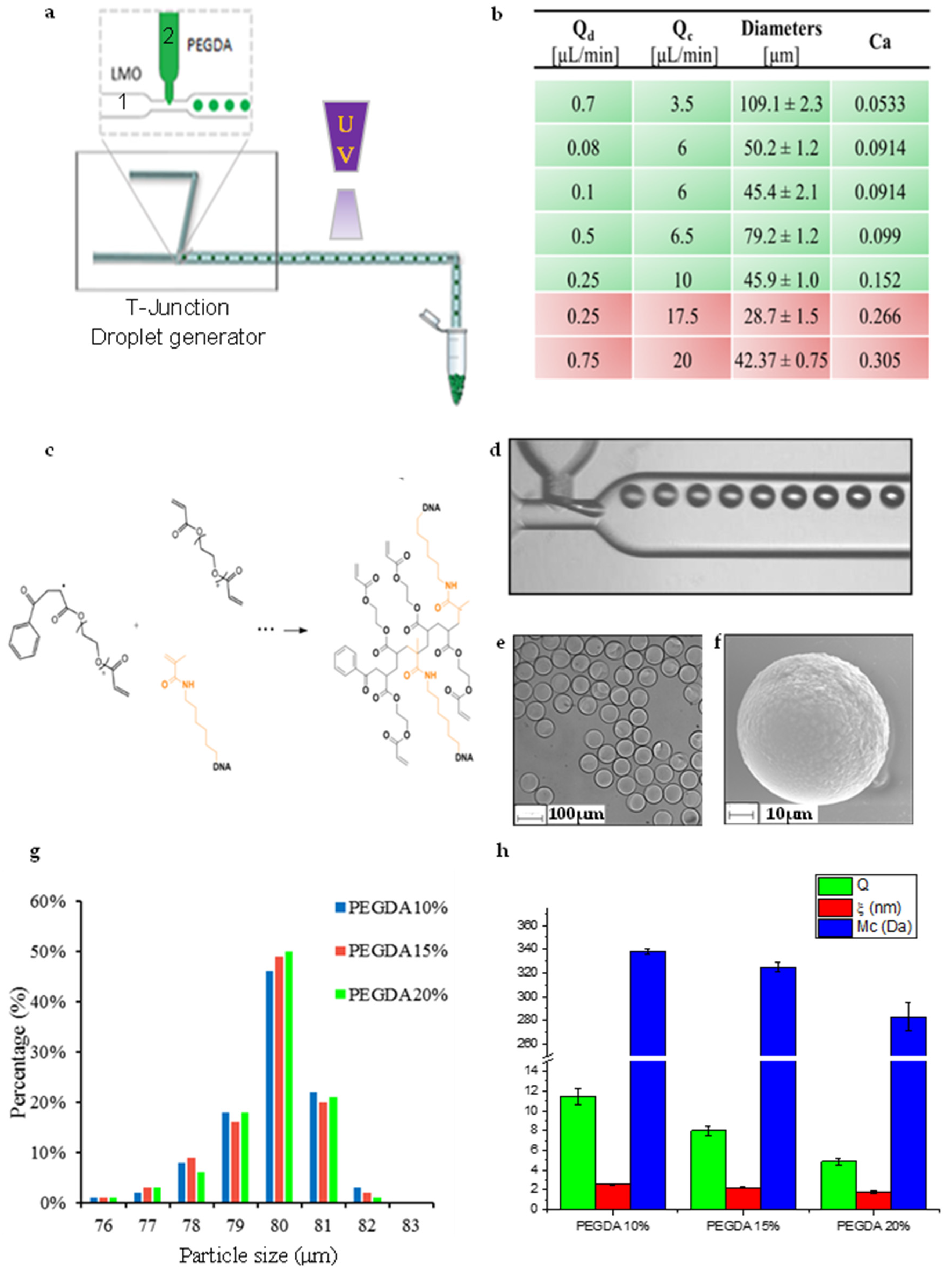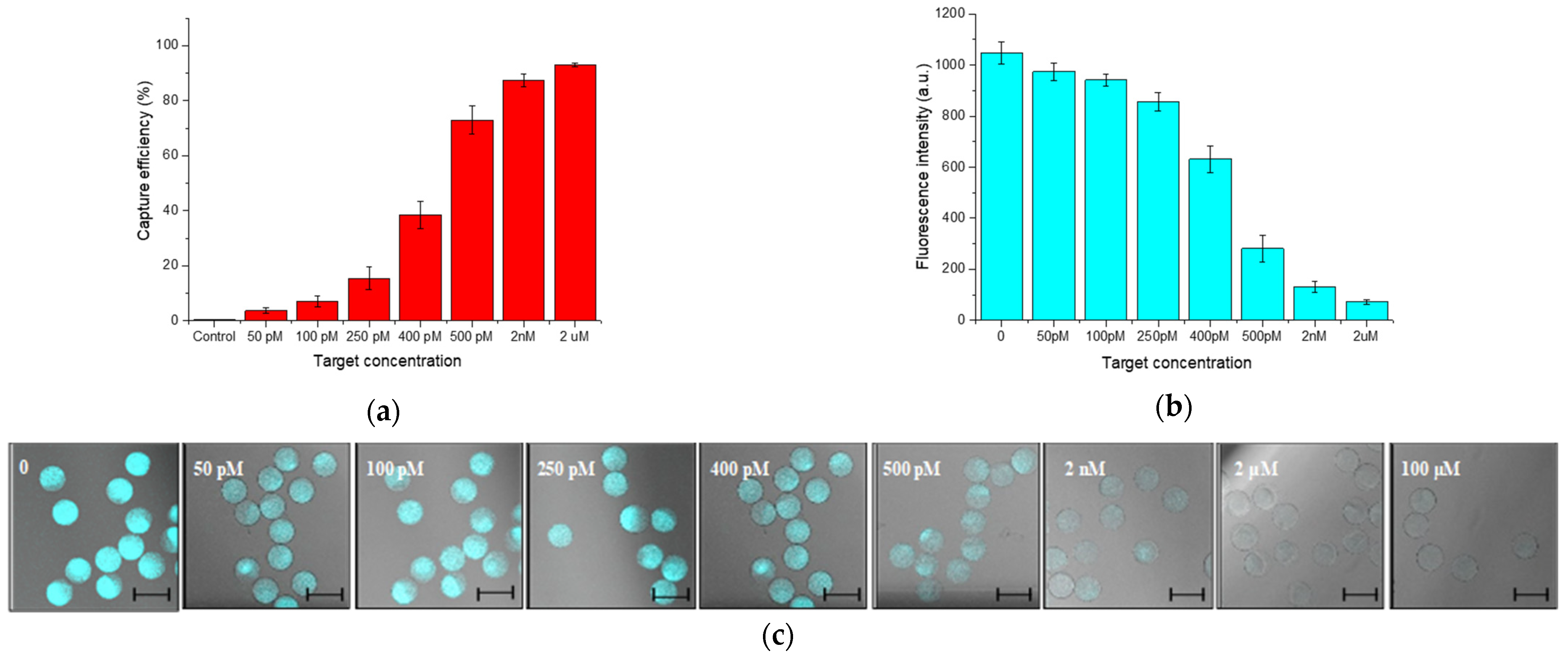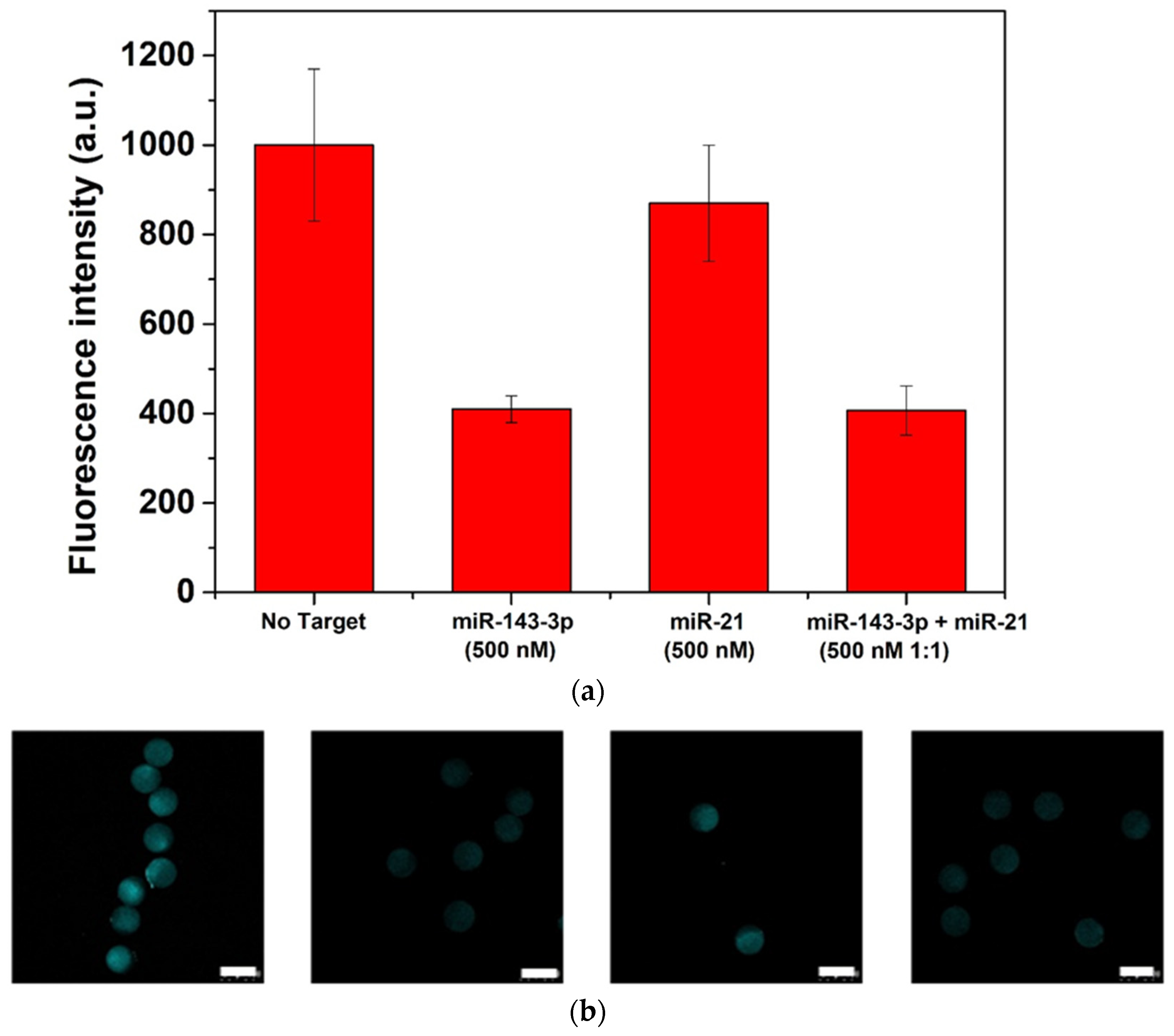Hydrogel Microparticles for Fluorescence Detection of miRNA in Mix-Read Bioassay
Abstract
:1. Introduction
2. Materials and Methods
2.1. Fabrication of Engineered Microparticles
2.2. Microparticles Characterization
2.3. Probe Design and Hydrogel-Beads Based Assay Set-Up
2.4. Assay Specificity
3. Results and Discussion
3.1. Microparticles: Synthesis and Characterization
3.2. Diffusion Studies
3.3. Human-miR-143-3p Detection in PBS and Human Serum
3.4. Assay Specificity
4. Conclusions
Supplementary Materials
Author Contributions
Funding
Institutional Review Board Statement
Informed Consent Statement
Conflicts of Interest
References
- Huang, X.; Liu, Y.; Yung, B.; Xiong, Y.; Chen, X. Nanotechnology-Enhanced No-Wash Biosensors for In Vitro Diagnostics of Cancer. ACS Nano 2017, 11, 5238–5292. [Google Scholar] [CrossRef]
- Carl, P.; Sarma, D.; Gregório, B.J.; Hoffmann, K.; Lehmann, A.; Rurack, K.; Schneider, R.J. Wash-Free Multiplexed Mix-and-Read Suspension Array Fluorescence Immunoassay for Anthropogenic Markers in Wastewater. Anal. Chem. 2019, 91, 12988–12996. [Google Scholar] [CrossRef] [PubMed]
- Tjong, V.; Tang, L.; Zauscher, S.; Chilkoti, A. “Smart” DNA interfaces. Chem. Soc. Rev. 2014, 43, 1612–1626. [Google Scholar] [CrossRef]
- Hu, J.; Liu, W.; Wang, J.; Qiu, J.-G.; Zhang, C. Simple Mix-and-Read Assay with Multiple Cyclic Enzymatic Repairing Amplification for Rapid and Sensitive Detection of DNA Glycosylase. Anal. Chem. 2021, 93, 6913–6918. [Google Scholar] [CrossRef]
- TCaputo, M.; Battista, E.; Netti, P.A.; Causa, F. Supramolecular Microgels with Molecular Beacons at the Interface for Ultrasensitive, Amplification-Free, and SNP-Selective miRNA Fluorescence Detection. ACS Appl. Mater. Interfaces 2019, 11, 17147–17156. [Google Scholar] [CrossRef]
- Gong, Q.; Wang, Y.; Yang, H. A sensitive impedimetric DNA biosensor for the determination of the HIV gene based on graphene-Nafion composite film. Biosens. Bioelectron. 2017, 89, 565–569. [Google Scholar] [CrossRef]
- Ravalli, A.; Marrazza, G. Gold and Magnetic Nanoparticles-Based Electrochemical Biosensors for Cancer Biomarker Determination. J. Nanosci. Nanotechnol. 2015, 15, 3307–3319. [Google Scholar] [CrossRef] [PubMed]
- Cao, Y.C.; Jin, R.; Mirkin, C.A. Nanoparticles with Raman spectroscopic fingerprints for DNA and RNA detection. Science 2002, 297, 1536–1540. [Google Scholar] [CrossRef] [Green Version]
- van Nguyen, K.; Minteer, S.D. DNA-functionalized Pt nanoparticles as catalysts for chemically powered micromotors: Toward signal-on motion-based DNA biosensor. Chem. Commun. 2015, 51, 4782–4784. [Google Scholar] [CrossRef] [PubMed]
- Wang, J.; Liu, G.; Jan, M.R.; Zhu, Q. Electrochemical detection of DNA hybridization based on carbon-nanotubes loaded with CdS tags. Electrochem. Commun. 2003, 5, 1000–1004. [Google Scholar] [CrossRef]
- Hwang, B.H.; Shin, H.H.; Cha, H.J. Optimization of DNA microarray biosensors enables rapid and sensitive detection. Biotechnol. Bioprocess Eng. 2017, 22, 469–473. [Google Scholar] [CrossRef]
- Daniel, C.; Roupioz, Y.; Gasparutto, D.; Livache, T.; Buhot, A. Solution-Phase vs Surface-Phase Aptamer-Protein Affinity from a Label-Free Kinetic Biosensor. PLoS ONE 2013, 8, e75419. [Google Scholar] [CrossRef] [PubMed] [Green Version]
- Traeger, J.C.; Schwartz, D.K. Surface-mediated DNA hybridization: Effects of DNA conformation, surface chemistry, and electrostatics. Langmuir 2017, 33, 12651–12659. [Google Scholar] [CrossRef]
- Macedo, L.J.; Miller, E.N.; Opdahl, A. Effect of Probe–Probe Distance on the Stability of DNA Hybrids on Surfaces. Anal. Chem. 2017, 89, 1757–1763. [Google Scholar] [CrossRef] [PubMed]
- Monserud, J.H.; Schwartz, D.K. Mechanisms of Surface-Mediated DNA Hybridization. ACS Nano 2014, 8, 4488–4499. [Google Scholar] [CrossRef] [PubMed]
- Schmitt, T.J.; Knotts, T.A., IV. A coarse grain model for protein-surface interactions. J. Chem. Phys. 2011, 134, 05B614. [Google Scholar]
- Nimse, S.; Song, K.; Sonawane, M.; Sayyed, D.; Kim, T. Immobilization Techniques for Microarray: Challenges and Applications. Sensors 2014, 14, 22208–22229. [Google Scholar] [CrossRef] [Green Version]
- Jang, J.H.; Dendukuri, D.; Hatton, T.A.; Thomas, E.L.; Doyle, P.S. A Route to Three-Dimensional Structures in a Microfluidic Device: Stop-Flow Interference Lithography. Angew. Chem. Int. Ed. 2007, 46, 9027–9031. [Google Scholar] [CrossRef] [PubMed]
- Ravan, H.; Kashanian, S.; Sanadgol, N.; Badoei-Dalfard, A.; Karami, Z. Strategies for optimizing DNA hybridization on surfaces. Anal. Biochem. 2014, 444, 41–46. [Google Scholar] [CrossRef]
- Peppas, N.A.; Hilt, J.Z.; Khademhosseini, A.; Langer, R. Hydrogels in Biology and Medicine: From Molecular Principles to Bionanotechnology. Adv. Mater. 2006, 18, 1345–1360. [Google Scholar] [CrossRef]
- Hoffman, A.S. Hydrogels for biomedical applications. Adv. Drug Deliv. Rev. 2012, 64, 18–23. [Google Scholar] [CrossRef]
- Ulijn, R.V.; Bibi, N.; Jayawarna, V.; Thornton, P.D.; Todd, S.J.; Mart, R.J.; Smith, A.M.; Gough, J.E. Bioresponsive hydrogels. Mater. Today 2007, 10, 40–48. [Google Scholar] [CrossRef] [Green Version]
- Mazzarotta, A.; Caputo, T.M.; Raiola, L.; Battista, E.; Netti, P.A.; Causa, F. Small Oligonucleotides Detection in Three-Dimensional Polymer Network of DNA-PEG Hydrogels. Gels 2021, 7, 90. [Google Scholar] [CrossRef] [PubMed]
- Chapin, S.C.; Appleyard, D.C.; Pregibon, D.C.; Doyle, P.S. Rapid microRNA profiling on encoded gel microparticles. Angew. Chem. 2011, 123, 2337–2341. [Google Scholar] [CrossRef] [Green Version]
- Ambros, V. The functions of animal microRNAs. Nature 2004, 431, 350. [Google Scholar] [CrossRef] [PubMed]
- Roderburg, C.; Koch, A.; Benz, F.; Vucur, M.; Spehlmann, M.; Loosen, S.H.; Luedde, M.; Rehse, S.; Lurje, G.; Trautwein, C.; et al. Serum Levels of miR-143 Predict Survival in Critically Ill Patients. Dis. Mark. 2019, 2019, 4850472. [Google Scholar] [CrossRef] [PubMed]
- Conti, I.; Simioni, C.; Varano, G.; Brenna, C.; Costanzi, E.; Neri, L.M. MicroRNAs Patterns as Potential Tools for Diagnostic and Prognostic Follow-Up in Cancer Survivorship. Cells 2021, 10, 2069. [Google Scholar] [CrossRef] [PubMed]
- Chen, X.; Ba, Y.; Ma, L.; Cai, X.; Yin, Y.; Wang, K.; Guo, J.; Zhang, Y.; Chen, J.; Guo, X. Characterization of microRNAs in serum: A novel class of biomarkers for diagnosis of cancer and other diseases. Cell Res. 2008, 18, 997. [Google Scholar] [CrossRef] [PubMed] [Green Version]
- Waller, R.; Goodall, E.F.; Milo, M.; Cooper-Knock, J.; da Costa, M.; Hobson, E.; Kazoka, M.; Wollff, H.; Heath, P.R.; Shaw, P.J. Serum miRNAs miR-206, 143-3p and 374b-5p as potential biomarkers for amyotrophic lateral sclerosis (ALS). Neurobiol. Aging 2017, 55, 123–131. [Google Scholar] [CrossRef]
- Xihua, L.; Shengjie, T.; Weiwei, G.; Matro, E.; Tingting, T.; Lin, L.; Fang, W.; Jiaqiang, Z.; Fenping, Z.; Hong, L. Circulating miR-143-3p inhibition protects against insulin resistance in Metabolic Syndrome via targeting of the insulin-like growth factor 2 receptor. Transl. Res. 2019, 205, 33–43. [Google Scholar] [CrossRef] [Green Version]
- Li, S.Y.; Zhang, Z.N.; Jiang, Y.J.; Fu, Y.J.; Shang, H. Transcriptional insights into the CD8+ T cell response in mono-HIV and HCV infection. J. Transl. Med. 2020, 18, 96. [Google Scholar] [CrossRef] [PubMed]
- Loureiro, D.; Tout, I.; Narguet, S.; Benazzouz, S.M.; Mansouri, A.; Asselah, T. miRNAs as Potential Biomarkers for Viral Hepatitis B and C. Viruses 2020, 12, 1440. [Google Scholar] [CrossRef]
- Peppas, N.; Bures, P.; Leobandung, W.; Ichikawa, H. Hydrogels in pharmaceutical formulations. Eur. J. Pharm. Biopharm. 2000, 50, 27–46. [Google Scholar] [CrossRef]
- Dendukuri, D.; Doyle, P.S. The synthesis and assembly of polymeric microparticles using microfluidics. Adv. Mater. 2009, 21, 4071–4086. [Google Scholar] [CrossRef]
- Celetti, G.; di Natale, C.; Causa, F.; Battista, E.; Netti, P.A. Functionalized poly (ethylene glycol) diacrylate microgels by microfluidics: In situ peptide encapsulation for in serum selective protein detection. Colloids Surf. B Biointerfaces 2016, 145, 21–29. [Google Scholar] [CrossRef] [PubMed]
- Baroud, C.N.; Gallaire, F.; Dangla, R. Dynamics of microfluidic droplets. Lab Chip 2010, 10, 2032–2045. [Google Scholar] [CrossRef] [Green Version]
- Battista, E.; Mazzarotta, A.; Causa, F.; Cusano, A.; Netti, P.A. Core Shell Microgels with Controlled Structural Properties. Polym. Int. 2016, 65, 747–755. [Google Scholar] [CrossRef]
- Nunes, J.; Tsai, S.; Wan, J.; Stone, H. Dripping and jetting in microfluidic multiphase flows applied to particle and fibre synthesis. J. Phys. D Appl. Phys. 2013, 46, 114002. [Google Scholar] [CrossRef]
- Li, X.-B.; Li, F.-C.; Yang, J.-C.; Kinoshita, H.; Oishi, M.; Oshima, M. Study on the mechanism of droplet formation in T-junction microchannel. Chem. Eng. Sci. 2012, 69, 340–351. [Google Scholar] [CrossRef]
- Abate, A.; Poitzsch, A.; Hwang, Y.; Lee, J.; Czerwinska, J.; Weitz, D. Impact of inlet channel geometry on microfluidic drop formation. Phys. Rev. E 2009, 80, 026310. [Google Scholar] [CrossRef] [Green Version]
- Cheng, Y.; Prud’Homme, R.K.; Thomas, J.L. Diffusion of Mesoscopic Probes in Aqueous Polymer Solutions Measured by Fluorescence Recovery after Photobleaching. Macromolecules 2002, 35, 8111–8121. [Google Scholar] [CrossRef]
- Causa, F.; Aliberti, A.; Cusano, A.M.; Battista, E.; Netti, P.A. Supramolecular spectrally encoded microgels with double strand probes for absolute and direct mirna fluorescence detection at high sensitivity. J. Am. Chem. Soc. 2015, 137, 1758–1761. [Google Scholar] [CrossRef] [PubMed] [Green Version]
- Caputo, T.A.; Cummaro, A.; Lettera, V.; Mazzarotta, A.; Battista, E.; Netti, P.A.; Causa, F. One-step scalable fluorescent microgel bioassay for the ultrasensitive detection of endogenous viral miR-US4-5p. Analyst 2019, 144, 1369–1378. [Google Scholar] [CrossRef] [PubMed]
- Wan, N.; Jiang, Y.; Huang, J.; Oueslati, R.; Eda, S.; Wu, J.; Lin, X. Rapid and Sensitive Detection of miRNA Based on AC Electrokinetic Capacitive Sensing for Point-of-Care Applications. Sensors 2021, 21, 3985. [Google Scholar] [CrossRef]






| Probe | Sequence (5′–3′) | Length (nt) | ΔG (Kcal/mol) |
|---|---|---|---|
| T-DNA | GCA CTG TAG CTC | 12 | TFhyb = −12.76 |
| F-DNA | TGA GAT GAA GCA CTG TAG CTC | 21 | FTargethyb = −22.62 |
| Target | GAG CUA CAG UGC UUC AUC UCA | 21 | ΔGdisplacement = −9.86 |
| Non-specific sequence | UAG CUU AUC AGA CUG AUG UUG A | 22 |
Publisher’s Note: MDPI stays neutral with regard to jurisdictional claims in published maps and institutional affiliations. |
© 2021 by the authors. Licensee MDPI, Basel, Switzerland. This article is an open access article distributed under the terms and conditions of the Creative Commons Attribution (CC BY) license (https://creativecommons.org/licenses/by/4.0/).
Share and Cite
Mazzarotta, A.; Caputo, T.M.; Battista, E.; Netti, P.A.; Causa, F. Hydrogel Microparticles for Fluorescence Detection of miRNA in Mix-Read Bioassay. Sensors 2021, 21, 7671. https://doi.org/10.3390/s21227671
Mazzarotta A, Caputo TM, Battista E, Netti PA, Causa F. Hydrogel Microparticles for Fluorescence Detection of miRNA in Mix-Read Bioassay. Sensors. 2021; 21(22):7671. https://doi.org/10.3390/s21227671
Chicago/Turabian StyleMazzarotta, Alessia, Tania Mariastella Caputo, Edmondo Battista, Paolo Antonio Netti, and Filippo Causa. 2021. "Hydrogel Microparticles for Fluorescence Detection of miRNA in Mix-Read Bioassay" Sensors 21, no. 22: 7671. https://doi.org/10.3390/s21227671
APA StyleMazzarotta, A., Caputo, T. M., Battista, E., Netti, P. A., & Causa, F. (2021). Hydrogel Microparticles for Fluorescence Detection of miRNA in Mix-Read Bioassay. Sensors, 21(22), 7671. https://doi.org/10.3390/s21227671







